The Future Of Fitness: Where Virtual Reality And AI Collide
This article contains affiliate links, meaning I may earn a commission if you click through and make a purchase. As an Amazon Associate, I earn from qualifying purchases. This comes at no additional cost to you. I only recommend products or services that I believe will provide value to my readers, based on personal experience or thorough research.
Fitness technology has dramatically shifted over the years, evolving from simple dumbbells and treadmills to advanced gadgets that monitor nearly every aspect of our physical health. This journey mirrors our growing understanding and appreciation of how technology can aid in achieving peak wellness.
Over the past decade, two tech giants—virtual reality (VR) and artificial intelligence (AI)—have stormed the fitness scene. These aren’t just gimmicks; they’re groundbreaking tools that are reshaping how we approach workouts and overall fitness routines.
Remember when wearing a step counter felt revolutionary? Now, imagine stepping into a fully immersive workout session that feels like a video game or having an AI-driven personal trainer who knows your strengths and weaknesses better than you do. That’s where we’re heading.
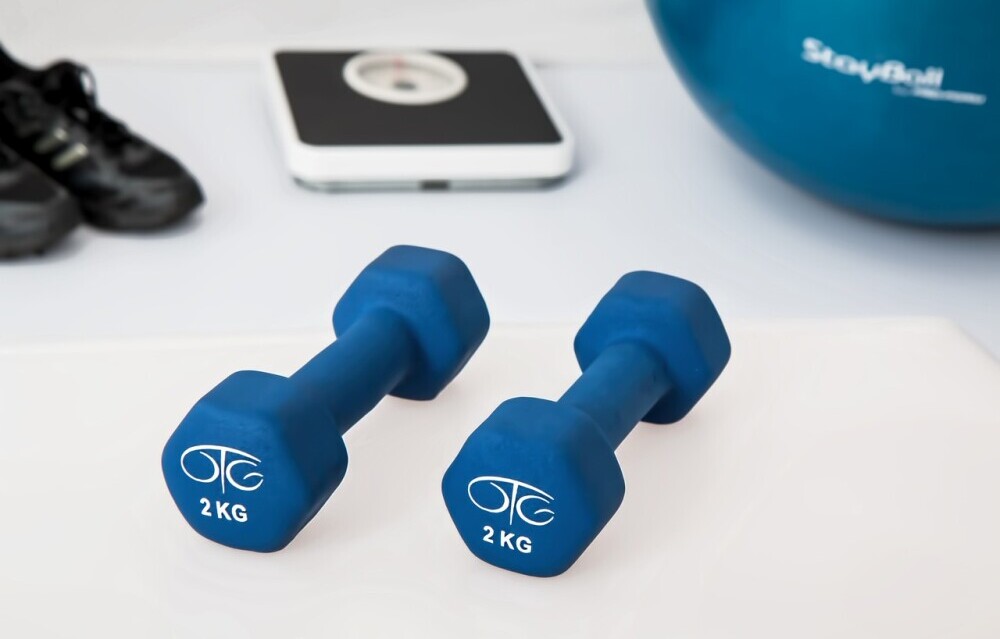
The fusion of VR and AI holds massive potential for transforming fitness. These technologies make workouts more engaging, efficient, and tailored to individual needs. Their rise also highlights an essential shift: fitness tech isn’t just about burning calories anymore. It’s about creating enriching, personalized experiences that keep users motivated and coming back for more.
VR Fitness: Transforming Workouts into Immersive Experiences
VR fitness is all about making workouts feel like an adventure rather than a chore. With VR, you aren’t just moving in place or lifting weights; you’re transported to virtual worlds where your fitness goals become part of an engaging storyline. It’s like gaming but with the added benefit of getting fit.
One major perk of VR fitness is its ability to keep motivation levels high. Traditional workouts can get monotonous, but VR offers diverse environments and experiences that are never the same twice. Imagine fighting dragons or navigating obstacle courses—all while burning calories. This element of fun and excitement can turn even the most reluctant exerciser into a fitness enthusiast.
Some standout VR fitness platforms include Supernatural, a full-body workout set in stunning landscapes, and Beat Saber, a rhythm-based game that doubles as a killer cardio session (see video below). Each of these platforms offers unique features, like personalized workouts and real-time feedback, making sure no two sessions feel alike.
Beyond fun, VR fitness is proving to be incredibly effective. Studies show that people exercise longer and with more intensity when they’re immersed in a virtual environment. This immersion helps to distract from fatigue, allowing users to push their limits safely. Plus, in the virtual world, every session can be customized to your fitness level, ensuring you’re always in that sweet spot of challenging yet achievable.
So, the next time you’re struggling to find the motivation to hit the gym, consider strapping on a VR headset instead. It might be the game-changer you need to turn fitness from a mundane task into a thrilling part of your day.
AI Personal Trainers: Customized Workouts for Every Individual
AI personal trainers are revolutionizing how we approach fitness by offering workouts tailored to individual needs. No longer is exercising about following generic routines that may or may not be effective. With AI, each workout is created with your unique goals, strengths, and limitations in mind.
These smart trainers analyze your performance in real-time, providing instant feedback to optimize your workouts. Imagine having a fitness expert who never tires, remembers all your preferences, and adapts your routine based on your progress. That’s what AI personal trainers bring to the table.
Leading AI fitness applications like Freeletics and Fitbod are great examples of this technology in action. Freeletics uses AI to create a hyper-customized workout experience that evolves as you do, while Fitbod generates daily workout plans tailored to the equipment you have available and your current fitness level.
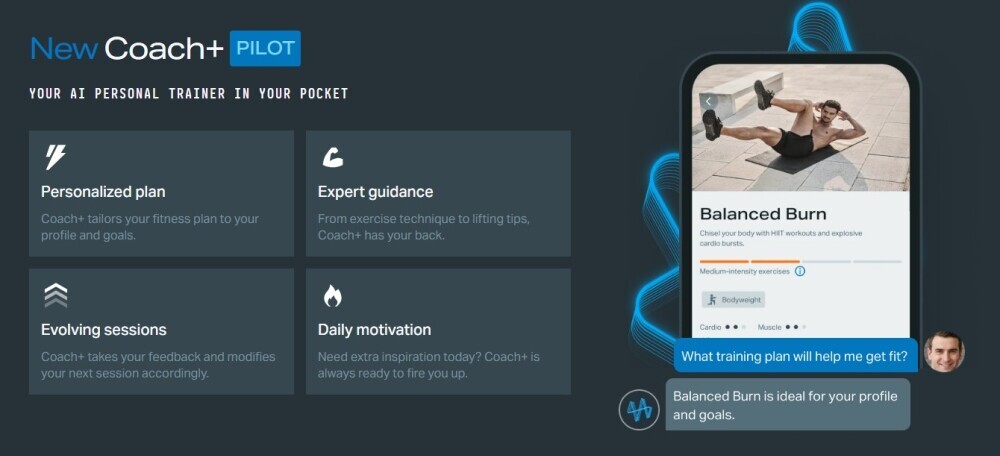
The beauty of AI trainers is their ability to make fitness accessible and productive for everyone, regardless of how experienced you are. Newbies get easy-to-follow guidance, while seasoned athletes receive advanced training insights. It’s like having a personal trainer in your pocket, providing the support you need to reach your fitness goals.
AI also makes workout adjustments on the fly. Did a routine feel too easy? Your AI trainer will crank up the intensity next time. Did it feel too hard? Expect a gentler approach in the future. This adaptability ensures you’re always at the optimal challenge level, keeping you engaged and progressing.
Personalization extends beyond just workouts. AI can also offer nutritional guidance, stress management techniques, and recovery advice, making it a holistic tool for overall well-being. With these smart trainers, you’re not just working out smarter; you’re living healthier.
The Convergence: Integrating VR and AI for Next-Level Fitness
Combining VR and AI in fitness is like having the best of both worlds. Together, they create a workout experience that’s immersive, smart, and infinitely adaptable to your unique needs. Think of it as having a gym that adjusts and reacts to you in real-time, making each session not just effective, but also exhilarating.
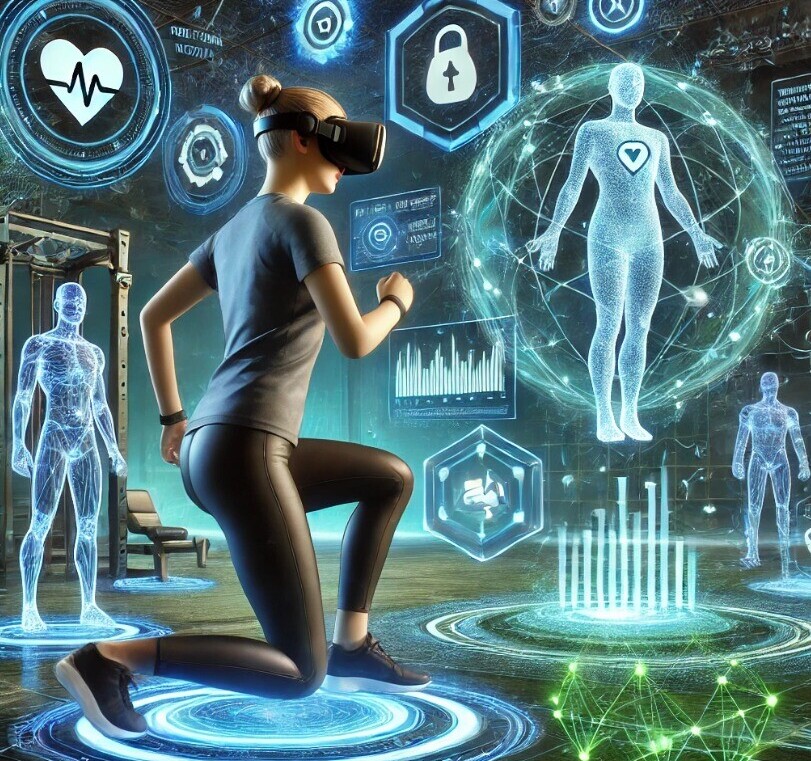
One way AI enhances VR fitness experiences is through intelligent adjustments. Imagine wearing a VR headset and battling it out in a virtual boxing ring. Your AI trainer monitors your performance, providing tips and adjusting the difficulty based on your fatigue levels and skill improvements. This level of customization makes each session feel fresh and challenging.
This integration also shines in making workouts more engaging. AI can design VR environments that are tailored to your interests, whether that’s a serene beach for yoga or a high-intensity circuit in a futuristic cityscape. The aim is to keep you fully engaged, making fitness feel less like a chore and more like an adventure.
Practical applications of this tech duo are already making waves. Platforms like YUR Fitness integrate VR and AI to provide a comprehensive workout, tracking your movement data and offering real-time feedback. This not only boosts efficiency but also ensures safety by preventing overexertion.
Looking ahead, imagine AI-driven avatars guiding you through a VR workout, correcting your form, and cheering you on as you hit new milestones. The fusion of these technologies promises to create a personalized fitness ecosystem that adapts not just to your body but also to your mind, keeping you motivated and on track.
Integrating VR and AI isn’t just a tech gimmick; it’s about harnessing the best of both worlds to create a revolutionary approach to fitness. As these technologies continue to evolve and mesh, expect your home workouts to feel like living in an ever-adapting, personalized fitness game. This is the future of fitness, where customization, engagement, and effectiveness collide.
Emerging Technologies: What’s on the Horizon?
With VR and AI already shaking up the fitness world, what’s next? Emerging technologies promise even more exciting developments. Expect to see new trends that push the boundaries of what’s possible in fitness.
One innovation gaining attention is augmented reality (AR). Unlike VR, which immerses you in a fully virtual environment, AR overlays digital elements onto the real world. Imagine running through your neighborhood with virtual checkpoints or following holographic fitness instructors in your living room. AR adds a new layer of interactivity and can blend seamlessly into daily routines.

Wearable tech is also evolving. Future devices will do more than just track steps and heart rates. Upcoming wearables are expected to monitor hydration levels, detect stress through sweat analysis, and provide deeper insights into recovery needs. This data can be fed into your AI trainer, making your fitness and wellness plan even more personalized.
Machine learning algorithms will become smarter and more nuanced. They’ll be able to predict your fitness needs based on past performance and even external factors like sleep patterns and nutrition intake. This will make your workouts more intuitive and dynamic.
Don’t overlook the potential of social fitness networks powered by AI and VR. These platforms can create virtual communities where users interact, compete, and share progress. Imagine joining a VR cycling class with friends from around the world or participating in global fitness challenges, all from the comfort of your home. These social elements can boost motivation and add a sense of camaraderie to solo workouts.
Lastly, voice recognition technology will improve, allowing seamless interactions with your fitness apps. Think of giving verbal commands mid-workout to adjust intensity, switch routines, or get real-time feedback. This hands-free approach will make workouts more fluid and intuitive.
The horizon is packed with innovations that will make fitness more engaging, personalized, and connected. Emerging technologies hold the promise of turning fitness into an integrated part of daily life, effortlessly blending with your routines and preferences. The future of fitness tech looks brighter and more revolutionary than ever.
Challenges and Considerations in VR and AI Fitness
As exciting as VR and AI fitness can be, it’s essential to consider some challenges. One major concern is privacy and data security. These technologies collect a lot of personal information, from workout stats to health data, and ensuring this information is kept secure is crucial. Always check the privacy policies of the platforms you use and be aware of what data is being collected and how it’s being used.
Another challenge is the physical and mental health implications. Extended use of VR can sometimes lead to issues like eye strain or dizziness, known as VR motion sickness. It’s important to take appropriate breaks and listen to your body to avoid any adverse effects. AI, while excellent at optimizing workouts, can occasionally push users too hard. Balancing intensity and rest is key to avoiding burnout or injury.
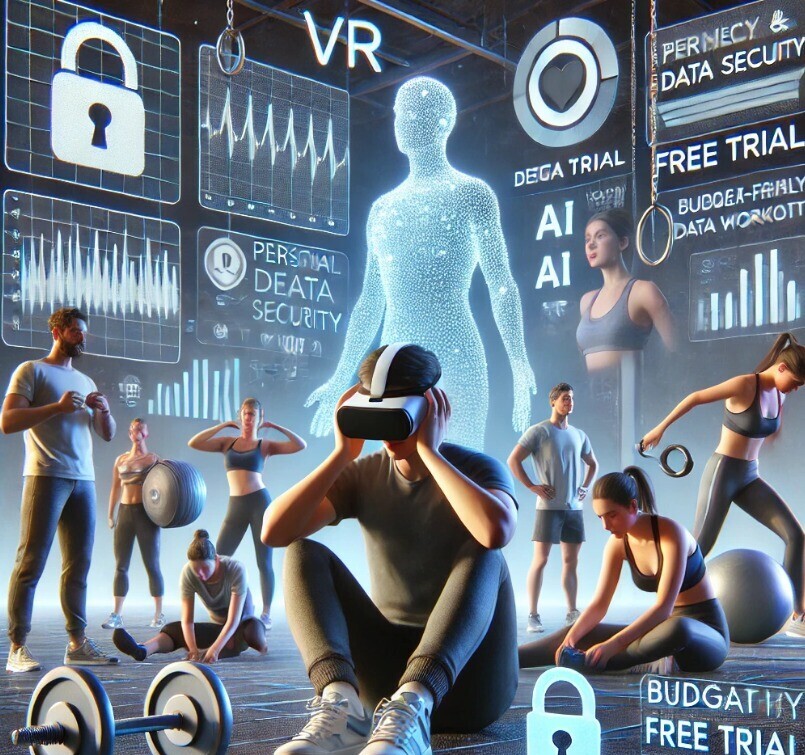
Accessibility is also a significant consideration. Not everyone has access to high-end VR equipment or the latest AI-driven apps. Developers are working on more affordable and accessible solutions, but there’s still a gap. Consider starting with more budget-friendly options or free trials to see if these technologies fit your lifestyle before investing heavily.
Inclusivity is another topic that can’t be overlooked. VR and AI fitness platforms need to cater to all fitness levels and abilities to truly succeed. This means providing modifications for those with disabilities or different fitness levels and ensuring everyone can benefit from these technologies. Look for platforms that offer diverse options and ensure they align with your needs and abilities.
Lastly, the social aspect of traditional workouts can sometimes feel missing in the virtual world. While VR and AI make solo workouts more engaging, they often lack the social interaction that group classes or gym sessions provide. Look for platforms that include social features, like virtual group workouts or community challenges, to keep that sense of connection alive.
Conclusion: Embracing the Future of Fitness
Tech-driven workouts aren’t just a trend; they’re the new norm transforming how we stay fit and healthy. VR makes fitness fun and immersive, AI delivers personalized training, and the synergy between these technologies takes workouts to new heights. Emerging innovations like AR and smarter wearables promise even more exciting possibilities on the horizon.
Overcoming challenges like privacy, accessibility, and inclusivity will be key to ensuring these advancements benefit everyone. The potential is immense, and it’s heartening to see how technology can align with our wellness goals.
The future of fitness is about more than just exercise—it’s about creating a balanced and engaging lifestyle. Staying on top of these trends can help you make the most of what’s available and tailor your fitness journey to your needs and preferences. Embracing these technologies means investing in your health in a way that’s innovative, personal, and, frankly, pretty cool.
So, whether you’re stepping into a virtual world for your next workout or letting an AI guide you through a tailored fitness plan, the key is to stay curious and open to new possibilities. The landscape of fitness is evolving rapidly, and those who embrace these changes will likely find themselves at the forefront of a healthier, more engaging way to work out.
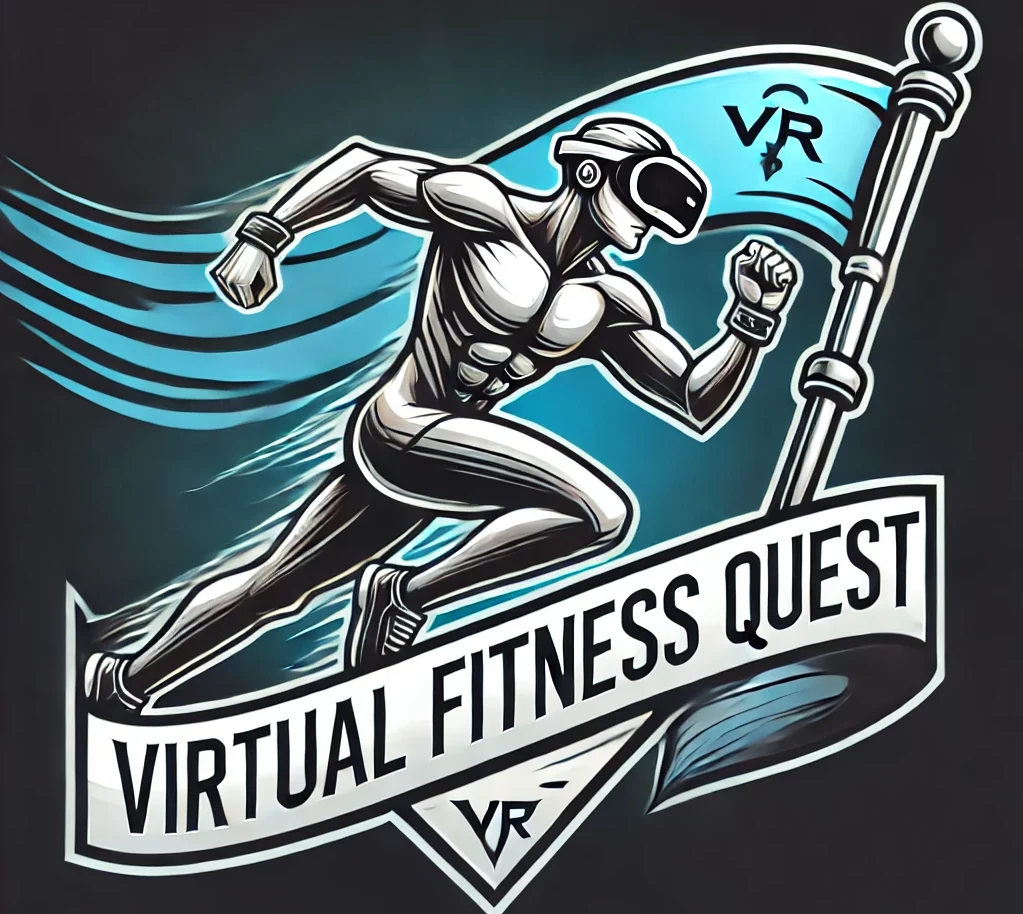
2 Comments